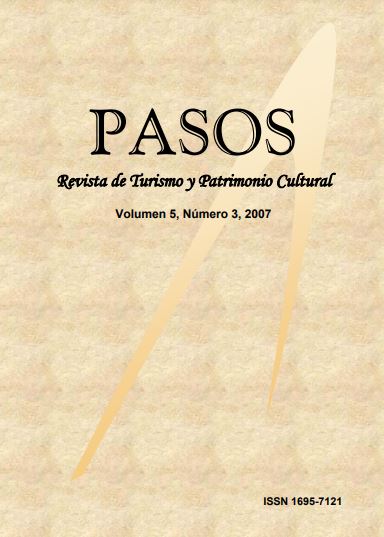Network management in companies and tourist destinations
DOI:
https://doi.org/10.25145/j.pasos.2007.05.030Keywords:
network management, Tourist destinationsAbstract
A network, is a system of two or more relationships connected to each other, in terms of each exchange relationship between employers/agents, must be interpreted from a collaborative point of view (Emer- son, 1981). In other words, a network is a system of connected agents that perform various types of interaction activities with each other. Therefore, a network consists of "nodes" or positions (occupied by various actors such as companies, diversified strategic business units, business associations, academic associations, public associations, as well as other types of organizations)(Thorelli, 1986).
Downloads
Publication Facts
Reviewer profiles N/A
Author statements
- Academic society
- PASOS. Revista de Turismo y Patrimonio Cultural
- Publisher
- Instituto Universitario de Investigación Social y Turismo. Universidad de La Laguna (España) - Instituto Universitario da Maia ISMAI (Portugal)
References
Augustyn, M. y Knowles, T. 2000 “Performance of tourism partnerships: a focus on York”. Tourism Management, 21: 341-351.
Avlonitis, G.J. Y Karayanni, D.A. 2000 “The impact of internet use on Business-to-Business marketing”, Industrial Marketing Management, 29: 441-459.
Bigné, J.E.; Viceriat, P. y Andreu, L. 2004 “Public & Private E-tourism Strategies: A Comparative Study between France & Spain”. Proceedings of the 2nd Tourism State of the Art Conference, University of Strathclyde, Glasgow.
Buhalis, D. 1998 “Strategic use of information technologies in the tourism industry”. Tour- ism Management, 19(5): 409-421.
Emerson, R.M. 1981 “Social exchange theory”. In M. Rosenberg & R. Turner, (Eds.), Social psychology: sociological perspectives (pp.30 – 65). Basic Books, New Cork.
Halinen, A, y Tornroos, J. A. 1995 “The meaning of time in the study of industrial buyer – seller relationships”. In K. Moller & D. Wilson (Eds.), Business marketing: an interaction and network perspective (pp. 493 – 529). Kluwer Academic: Norwell, MA.
Hakansson, H. y Snehota, I. (1995). Developing relationships in business net- works. London: Routlege.
Lynch, P. A. 2000 “Networking in the homestay sector”. The Services Industries Journal, 20(3): 197 - 223
Morrisson, A., Lynch, P. y Johns, N. 2004 “International tourism networks”. International Journal of Contemporary Hospitality Management, 16(3): 197 – 202.
Nonaka, I. y Takeuchi, H. 1995 The Knowledge-Creating Company. Oxford University Press.
Pechlaner, H., Abfalter, D., y Raich, F. 2002 “Cross-border destination management systems in the Alpine Region – The role of Knowledge network on the example of Alpnet”. In Bouncken, R. and Pyo, S. (Eds). Knowledge Management in Hospitality and Tourism (pp. 89 – 107), The Haworth Hospitality Press, New York.
Pechlaner, H., y Tschurtschenthaler, P. 2002 Tourism Policy, Tourism Organizations and Change Management in Al- pine Regions and Destinations, A European Perspective in Current Issues in Tourism.
Ritter, T. y Gemünden, H.G. 2003 “Interorganizacional relationships and networks: An overview”. Journal of Business Research, 56(9): 691-697
Roy, S.; Sivakumar, K. y Wilkinson, I.F. 2004 “Innovation generation in supply chain relationships: A conceptual model and research propositions”. Journal of the Academy of Marketing Science, 32(1): 61-79.
Sigala, M. 2004 Collaborative Supply Chain Management in the airline sector: the role of GDS. Advances in Hospitality & Leisure.
Skyrme, D. 1999 Knowledge networking: creating the collaborative enterprise. Butterworth Heinemann. Oxford
Thorelli, H.B. 1986 “Networks: between markets and hierarchies”. Strategic Management Journal, 7: 37 – 51
Downloads
Published
How to Cite
Issue
Section
License
I confirm that the work is original (of my/our authorship), and that it will not be submitted to other journals or publications until the final resolution of the review process in PASOS, RTPC.
I authorize the publication of my work by PASOS, PSTN of free and open access in any of the formats that I deem appropriate, for an indefinite period of time and as a non-remunerated collaboration.
Likewise, the author(s) understands that the published work may be linked or deposited on any server or included in other publications (republication), provided that the new place and/or new edition references the original publication and acknowledges the authorship and copyright ownership of PASOS RTPC publications.
Authors understand that a plagiarism-self-plagiarism check will be performed, and the article may be removed at any time from the editorial flow.










